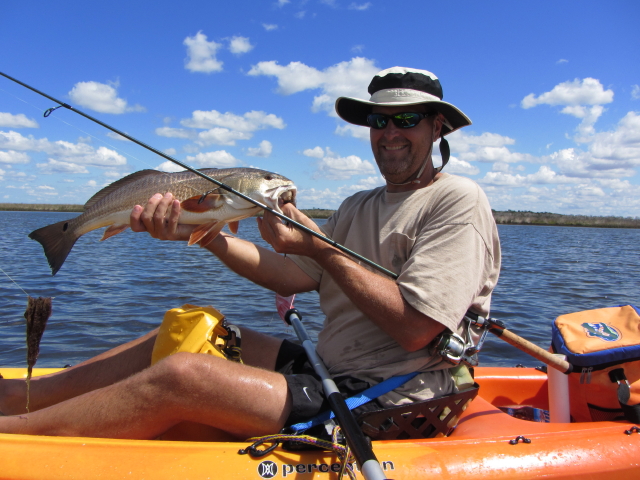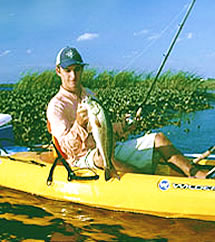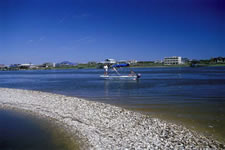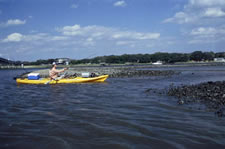October 12, 2016
By David Brown
Fish the oyster bars for light tackle fun.

There are no overpriced drinks, no shaky sound systems, no shallow conversations. But when inshore anglers long for entertainment seasoned with diversity, many turn to bar-hopping. Oyster bars, that is.
On the terrestrial clubbing scene, you have your garden-variety neon palaces where party people gather en masse to do their thing and watch others do theirs. It's high-vis, sexy, eye candy. Kind of like a dense mangrove shoreline where herons, egrets and spoonbills adorn crisp green foliage.

Silently slipping to within casting distance of an exposed bar often lands you in prime redfish territory.
|
Then you have your modest, unassuming hole-in-the-wall dives where less-than-opulent décor belies an endearing ambiance and the cool vibes of heart-and-soul musicians. Kind of like an oyster bar.
Certainly not the most photogenic of fishing habitat, shell bars are usually dull, dark and sopped with slick, pungent mud. But like they say in the honey business— beauty is in the eye of the bee holder. Or something like that.
Anglers in the know gaze with affection at a knobby, gnarly mound of bivalves. Whether it's a crescent-shape bar stretching 100 feet or a small clump of shells sprouting before a drainpipe in a residential canal, the intrigue is undeniable. Formed where fresh water flows into salt, the accumulated colony of oyster growth is truly the place to find a little less talk and a lot more action.
Popular patrons of the oyster bar include redfish, snook, black drum, sheepshead and flounder. Occasional guests include jack crevalle, bluefish and cobia like the 30-pounder that I saw plucked from a small bar off the Anclote River channel. This all-star lineup means action aplenty. But for those of lesser stature, an oyster bar is a place to see and not be seen.
Indeed, food sources are the big draw and oyster bars pack a lot of chow. Boasting a bounty of briny delights, oyster bars tempt predatory patrons with a variety of dining options. Some meals are resident entrées, while other—finger mullet, for example—are just passing through.
Carefully lift a clump of damp oyster shells and take a peek at the menagerie of sealife hiding in and around the bivalves. Small invertebrates wiggle in the muddy roux, while dime-sized crabs try to flatten themselves into protective obscurity. Dip your finger into the dark puddle where your oyster clump once sat and you'll often see the short, stout claws of a young stone crab raised in territorial threat. Shrimp, pinfish and various “mud minnows” round out the feast.

Bar edges that drop into channels are an excellent choice.
|
In addition to the chow, oyster bars appeal to gamefish with protection and concealment. Not only does a bar offer something to hide behind when sharks, porpoises or ospreys come a calling, but tidal carvings create deeper dropoffs that provide quick exit routes.
Now, if one thing's common to all nightclubs, it's the propensity for folks to gather near particular areas: the bar, the dance floor, the bathroom line. Likewise, fish will pay a little more attention to certain features of an oyster mound. Run-out creeks, for example, create food funnels that concentrate baitfish and crustaceans swept out with a falling tide. Larger drains see fish poking as far back as the water allows. At smaller canals, fish stage near the mouths to ambush hapless prey.
Where multiple bars stand in close proximity, the cuts between structures create similar funneling. Often these passes hold deep water leading into an inner lagoon meriting a cast or two.
Tidal points also create predator-friendly dynamics, especially during swift water movement. During a kayak fishing trip in the Matanzas River near St. Augustine, my guide drifted his boat abeam to a large oyster mound where the outgoing tide trickled in sheets off an adjacent mudflat, gathered itself and raced around the bar's tip. When the water passed his position, it hit a deep hole and tumbled over itself with a noticeable chop. Nearly every cast through this turbulent spot yielded a strike from redfish that were undoubtedly lined up to capitalize on the food delivery service.
These and other oyster bar features are often hidden at high tide, but visiting during low water stages and mentally mapping shapes, elevations, runouts and ambush points will afford you more than a hit-and-miss approach. Photos—especially from a tower or poling platform—can prove invaluable.

You can bend a rod at small cuts between bars.
|
Oyster bar anglers must plan their moves for maximum exposure. Here, the tide is like a doorman who won't let you in until all is ready and quickly ushers you on your way when it's time to go. But don't expect 24/7 action. Just like any well-maintained establishment, the sea must periodically close its doors to sweep up and restock its facilities. Dead low tide gives a bar time to reset itself, while the edible staff repositions for the next round of survival.
Temperature modification also factors here, as a bar's ability to soak up the sun's warmth and then radiate the heat gives fish one more reason to visit. Low tide also allows oyster bars a chance to soak up direct sunlight, thereby increasing their attraction to larger fish—especially important during chilly periods. The darkest and muddiest bars, the ones that look grayish brown, absorb and retain the most heat.
When timing your visits, consider that the more sun time a bar gets, the more it will attract fish during the cooler hours of morning and evening. In warm conditions, it's all about cooling down a bar and invigorating the structure, along with its surroundings with fresh oxygen from an incoming tide.
Now bars aren't always immediately visible and during higher tide stages, productive spots may disappear under just enough water to hide their crown. Look for ripples on the surface, wading birds that appear to be standing on the surface and foam lines where water washes over barely concealed bars.
When tides flood popular bars, anglers often rely on local knowledge and GPS coordinates to locate the sweet spots. Just be very cautious, even when idling through unfamiliar waters, lest you suffer S.P.D. (sudden prop detachment).
When a bar sits exposed, you can tell how much time it spends submerged by its color. Dark hues mean a regular rinsing of tide-born mud. Light-colored shells indicate that at least the bar's crown has spent a lot of time drying and bleaching in the sun. Such hints give you an idea of how the water works around the bar and where your quarry may be oriented.
Now spend an hour in a club and you'll see an eclectic blend of dance movesand even more creativity in the pick-up lines. To put it kindly, some work and some don't.
Oyster bar anglers have many options as well, and, of course, some produce better than others. This is not a place for trolling, and anything that drags bottom is unlikely to yield much more than an exercise in frustration.
That said, jigs with shad tails or tubes can actually prove effective as long as you keep them moving and deftly bouncing over stingy shells. The heightened sensitivity of braided line facilitates this and if you do hang on a shell, you'll stand a better chance of dislodging the offending clump with braid than with mono.
A close alternative to the leadhead jig is a soft-bodied swim bait. With pliable plastic overlaying the weighted hookshank, you can effect a similar dive and dance action, but the soft form is more likely to bounce over shells than the rigid metal of a traditional jighead.

The mouths of tributaries, framed by oysters, attract reds during moving tides.
|
You'll also do well with soft-plastic jerkbaits rigged on a 2/0 or 3/0 wide-gap worm hook. With these sleek and slender forms, you can work several actions from a fast-paced surface twitch, to a simulated wounded minnow flutter, to a dead-stick presentation. The latter is most effective in slower water and scented soft plastics help attract attention.
When the tide's high enough, topwaters will often draw vicious early morning trout strikes. Keep a subsurface bait handy and if a redfish boils on the floater but misses, sling a jig or jerkbait right at the point of contact, and you'll often score on the second chance. Spoons are also good, but keep your rodtip up and don't let the lure sink into snag range.
Live or cut shrimp is always a good bet. On the sides with current breaks you can weight your bait with a splitshot or thread it onto a jighead and let it sit near the bottom. When working a bait through a current rip, fish it higher in the water column so the flow doesn't tumble your rig into a snag. Freelining or floating live shrimp, pinfish or pilchards will work.

Shell mounds with vegetation and shallow flats are worth a cast or two.
|
In deeper dropoffs, try bouncing a jig and shrimp along the slope and across bottom. Use just enough weight to punch through any current and keep the bait moving to prevent hangups.
A common tactical error occurs when anglers determine that the tide is too low to reach a bar and then depart for other locations. True, forcing your way into treacherously shallow water—no doubt strewn with a random assortment of hard things—is like elbowing your way through a crowded biker bar en route to the watering hole. You might reach your objective, but a costly journey that would be.
The better move would be to position your boat between the bar and the nearest deepwater source. Considering that a steady stream of predators will be sliding in with the rising tide, working baits through perimeter waters will likely connect you with fish seeking their next meal. As the water fills, move a few yards closer and continue this incremental approach until you reach your objective.
Wading offers another viable option, but without thick-soled shoes that come at least as high as your ankles, yours could become a painful stroll. Oyster shells may look broad and lumpy from a distance, but the edges are mercilessly sharp. Standing still, your bodyweight alone is enough to cause lacerations.
When walking over oyster bars, move slowly with measured steps. It's next to impossible to completely neutralize the noise of footsteps across shifting shells, but beware the noisy—and dangerous—slipping hazards on loose edges and avoid kicking any loose clusters.
Moreover, stay clear of the soft mud piled around a bar's extremities. It's like walking through oatmeal, and grabbing at oyster mounds for leverage is a good way to remove your fingerprints.
By foot or by boat, oyster bars present plenty of opportunities for those who would hop their way. Consider this: As long as you're persistent on this bar scene, you have a pretty good chance of hooking up—regardless of how much cologne you wear. And if the party goes longer and harder than expected, you'll never need a designated driver.
Scent-Sibly Chic
A decent club will attract a decent crowd, but throw a dance contest, or celebrity appearance into the mix and you'll really pack the house. With oyster bars, chumming can stimulate feeding and call in diners who've not yet committed.
Of course, tossing out a handful of live sardines is a quick way to see if the bar holds hungry snook or redfish. The violent surface pops tell you that the freebies have done their job.
Less visible, but equally effective are bits of cut shrimp scattered around the bar. Pinfish will steal a lot of the freebies, but redfish and black drum will smell the appetizers and follow the scent to its source. Even if a swarm of pinfish ravages your chum, these hardy baits are staples on the redfish, trout and snook diet. Congregating a bunch near your bar isn't a bad thing at all.
Other creative options include dispensing menhaden oil or crab and shrimp scented oils. Dripping or squirting oils uptide of the bar can help coax fish into casting range, but if you wade into the spot at low tide and douse the perimeter with scented oils, the place will hold an elevated attraction that can serve to rally and hold the fish for easy pickings once the water returns.
And don't overlook the psychological chumming potential of audible teasers. Live baits fished under popping corks or the popular jig-and-cork rig enable you to simulate feeding sounds with a vigorous tug on the float. Trout are quick to respond when they think a neighbor has found a food source.
FS
